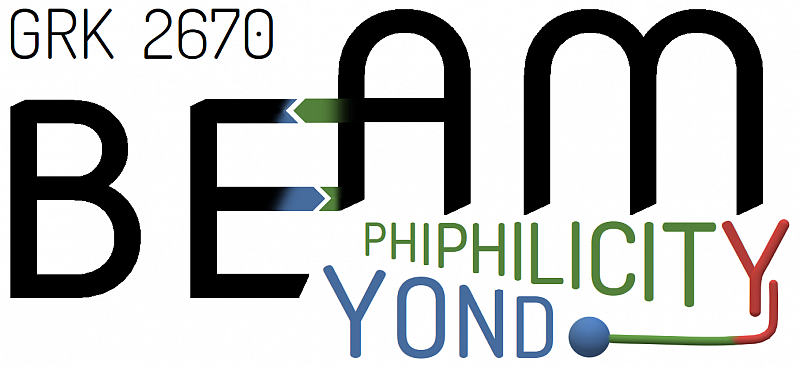1. Beam Symposium
From 06. to 08. September 2023 our first BEAM Symposium took place in Halle (Saale)!
Topics:
- intermolecular Interactions
- function and ordering of liquid crystals
- solvation of molecules
- diffusive motion of comples molecules
- mathematical description of symmetry
- protein engineering & directed evolution
- covalent organic frameworks
- supramolecular self-assembly of polymers & complex materials
- polyphillic protein-membrane interactions
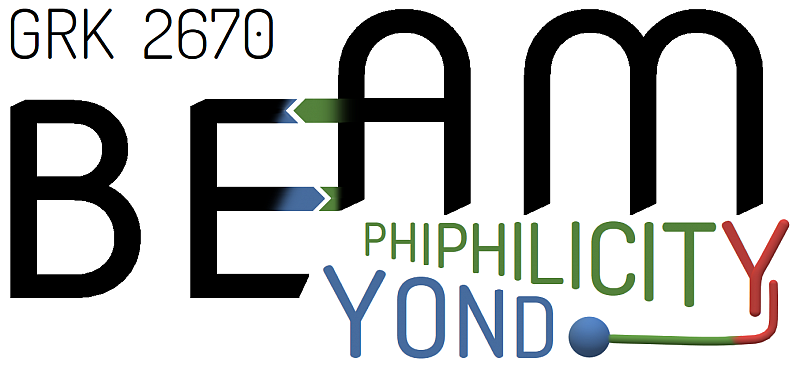
Speakers:
Thisbe Lindhorst
CAU Kiel, GER
Sandro Keller
KFU Graz, AUT
Bettina Keller
FU Berlin, GER
Silvia Spezzano
MPI extraterr. physics, GER
Peter Schreiner
JLU Giessen, GER
Carla Schmidt
JGU Mainz, GER
Michael Vogel
TU Darmstadt, GER
Oren A. Scherman
University of Cambridge, GB
Beate Paulus
FU Berlin, GER
Nina Morgner
Universität Frankfurt, GER
Yoko Yamakoshi
ETH Zürich, CH
program:
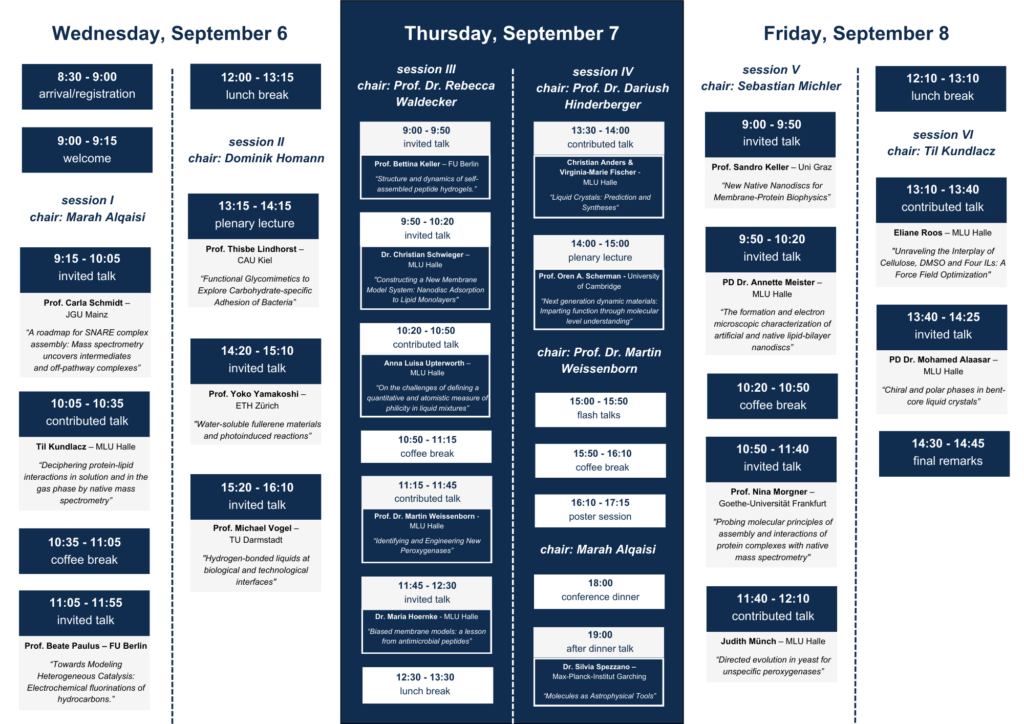
You can download the program as a pdf file via the following link:
Abstracts:
Thisbe Lindhorst
CAU Kiel
“Functional Glycomimetics to Explore Carbohydrate-specific Adhesion of Bacteria”
Every cell is covered by a dense layer of glycoconjugates which is called “glycocalyx”. The glycocalyx functions as an extracellular cell organelle and it forms the first compartment of all cells to interact with the cellular environment and other cells. As such, the glycocalyx has been implicated in a vast range of cellular processes in physiological as well as disease states. However, the numerous studies and findings underpinning the biological importance of the glycocalyx fall short of tying structure directly to function. Furthermore, causal relationships that have been characterized have not yet been integrated into a comprehensive model of how carbohydrate recognition functions in a supramolecular environment.
As the glycocalyx also constitutes the first point of contact for microbes like viruses and bacteria, we have used a defined model system of mannose-specific bacterial adhesion to glycosylated surfaces in order to explore the details of carbohydrate recognition in a bottom-up approach. To this end, we have employed tailor-made glycomimetics allowing to address very specific effects of structure-function relationships in carbohydrate recognition. Canonically, carbohydrate recognition is thought to be mainly governed by the stereochemical features of specific glycoligands and their multivalent presentation. However, we have shown that another central feature of carbohydrate ligands is their three-dimensional (3D) presentation in a supramolecular context employing photosensitive “sweet switches” as well as stereo- und regioisomeric heterobivalant glycoclusters (cf. Angew. Chem. Int. Ed. 2014, 53, 14583-14586; Chem. Commun. 2016, 52, 1254-1257; Org. Biomol. Chem. 2021, 19, 7013-70239).
Nina Morgner
Universität Frankfurt
“Probing molecular principles of assembly and interactions of protein complexes with native mass spectrometry”
Protein complex assembly as well as their interplay are controlled by the non-covalent interactions of all biomolecular partners. Native mass spectrometry and ion mobility are ideally suited to unravel the molecular principles which tightly control these interactions. Here I will present what we can learn about well-choreographed assembly strategies of a multi protein complex such as an ATPase or rather unwanted aggregation as seen for the Alzheimer related Amyloid b peptide. For the example of photoreceptors I will show how instrumental modifications can allow for time resolved studies of light dependent conformational rearrangements and oligomerization upon illumination.
Silvia Spezzano
MPI extraterr. physics
“Molecules as Astrophysical Tools”
The gas composing the interstellar medium (ISM) is inherited from old stars and, at the same time, feeds into new stars and, eventually, new planets. Understanding the chemistry in the processes of star and planet formation is a crucial step into revealing not only the chemical, but also the physical processes that drive these phenomena. Stars form in dense cloud cores that can be studied through the emission of cold dust and molecules. Dense cores have a relatively high column density of dust, which effectively blocks the ambient radiation in the optical and ultraviolet regions of the electromagnetic spectrum. Thanks to this shielding, molecules can survive, and molecular complexity can be built. Molecular emission in such dense cores is how we can observe the process of star-formation and study the chemical evolution from clouds to stars and planets. Because of the interconnection between the chemistry and the physics of dense cores, identification of molecules can be used to study the dynamics of the star-formation process, as well as the chemical budget that will finally be inherited by the forming planets. In my talk i will give a general introduction of Astrochemistry through its three pillars: laboratory spectroscopy, astronomical observations, and modelling.
PD DR. Mohamed Alaasar
MLU Halle
“Chiral and polar phases in bent-core liquid crystals“
Spontaneous mirror symmetry breaking in achiral molecules is a challenging task with significant interest for fundamental scientific research and technological applications. Azo functionalized materials are of special interest due to their photo responsive nature, which can be exploited for optical and optoelectronic devices. The discovery of polar order and mirror symmetry broken chiral mesophases formed by bent-core liquid crystals BCLCs [1,2] opened the door to polar LCs formed by achiral molecules. Combining the ferroelectric and the photo switchable nature of the azobenzene units could lead to potential new multifunctional materials in which the polar response can be modified with light. For this reason, BCLCs attracted the attention of several researchers in recent years.[3-5]
The focus of this talk will be about the different types of chiral LC phases observed in achiral azobenzene-based BCLCs as well as on polar phases exhibited by such materials. This aims to provide an understanding of the development of polar order in these molecules. The discussed BCLCs are derived from different 4-substituted resorcinol core unit attached to symmetric on non-symmetric side arms (see Figure 1).

The molecular self-assembly of these molecules was characterized by differential scanning calorimetry (DSC), polarizing light microscopy (PLM), electro-optical and X-ray diffraction (XRD). The fine tuning of the molecular structure leads to photo responsive materials showing fast and reversible photoinduced change of phase polarity as well as switching between achiral and chiral liquid crystalline phases.
References
[1] T. Niori, T. Sekine, J. Watanabe, T. Furukawa, H. Takezoe, J. Mater. Chem., 6, 1231 (1996).
[2] R. A. Reddy and C. Tschierske, J. Mater. Chem., 16, 907 (2006).
[3] M. Alaasar, Liq. Cryst., 43:13-15, 2208 (2016).
[4] A. Lehmann, M. Alaasar, M. Poppe, S. Poppe, M. Prehm, M. Nagaraj, S. P. Sreenilayam, Y. P. Panarin, J. K. Vij, C. Tschierske, Chem.–A Eur. J., 26, 4641 (2020).[5] M. Poppe, M. Alaasar, A. Lehmann, S. Poppe, M.-G. Tamba, M. Kurachkina, A. Eremin, M. Nagaraj, J. K. Vij, X. Cai, F. Liu, C. Tschierske, J. Mater. Chem., 8, 3316 (2020).
Christian Anders & Virginia-Marie Fischer
MLU Halle
“Liquid Crystals: Prediction and Syntheses“
The research on self-assembling systems is a fascinating field of natural science that is used in a wide variety of applications like sensor technology (1), electronic devices (2), or even in the development of complex biomolecular structures (3). Liquid crystals (LCs) exhibit ideal self-assembly conditions due to the combination of the order of the solid crystalline state with the fluidity of liquids. The X- and Tshaped bolapolyphiles occupy a special position within LCs since they can self-assemble into various
complex LC phases (4,5). These structures include polygonal honeycombs consisting of triangular, square, pentagonal, hexagonal, and even larger cells which can be described as 2D tiling patterns belonging to different crystallographic plane groups. The shape of the polygonal honeycombs is largely determined by the structure of the linear rigid core and the side chains of the involved polapolyphiles. The X-shaped molecules shown below were designed to be located at the transition between triangular and square honeycombs and thus were expected to form honeycombs combining triangular with square cells, potentially leading to quasiperiodic tessellations. The common way of influencing the shape of the
polygonal honeycombs is to systematically change the volume and the shape of the side chains (red in the formula), which is time-consuming and cost-intensive.

In a joint project between chemistry and mathematics, we want to solve these problems through a new way of molecular design. With the aid of a geometric model, we try to address the problem of the
predictability of LC phases in order to facilitate the design of new molecules capable of self-assembling into new complex tiling patterns. For shown molecules, we developed a geometric model for an
effective design of triangular, square, and quasiperiodic 2D patterns. This model is based on experimental data such as POM, DSC, and SAXS measurements of previously synthesized compounds as well as on geometrical abstraction. Based on these predictions new X-shaped bolapolyphiles (see formula) were designed and synthesized whose modes of self-assembly agreed well with the predictions.
References
(1) H.-R. Kim, J.-H. Kim, T.-S. Kim, S.-W. Oh and E.-Y. Choi, Appl Phys Lett, 2005, 87, 143901.
(2) J. W. Goodby, J. P. Collings, T. Kato, C. Tschierske, H. F. Gleeson and P. Raynes, Handbook of Liquid Crystals, Willey-VCH, Weinheim, 2nd edn., 2014.
(3) S. Li, T. Tian, T. Zhang, X. Cai and Y. Lin, Materials Today, 2019, 24, 57.
(4) S. Poppe, M. Poppe, H. Ebert, M. Prehm, C. Chen, F. Liu, S. Werner, K. Bacia and C. Tschierske, Polymers (Basel), 2017, 9, 471.
(5) X. Cheng, M. Prehm, M. K. Das, J. Kain, U. Baumeister, S. Diele, D. Leine, A. Blume and C. Tschierske, J Am Chem Soc, 2003, 125, 10977.
Oren A. Scherman
University of Cambridge
“Next generation dynamic materials: Imparting function through
molecular level understanding“
Over the last decade, supramolecular polymer networks (SPNs) have emerged as an exciting new area within the fields of supramolecular and polymer chemistry, materials science as well as biomedical engineering. We have pioneered the use of cucurbit[8]uril (CB[8])-mediated interactions as dynamic crosslinks for the design and preparation of new classes of SPNs with tuneable viscoelasticity and multiple stimuli-responsive features (JACS, 2010 & 2012). Although significant advances have been made, a major challenge remains endowing SPNs with robust and controllable material properties. To address this challenge, we reported the introduction of crosslinks formed through CB[8]-mediated π-π interactions between guest moieties with a high binding affinity (Ka > 1012 M-2 ). This resulted in dynamic, yet strong crosslinks and the fabrication of rubber-like SPNs with remarkable stretchability (> 100x), high toughness (>2000 J/m2 ), rapid self-healing and self-recovery. This platform provided a facile strategy for the development of SPNs with robust mechanical properties and promising applications as strain sensors and in electronic devices (Adv. Mater., 2017 & 2017). We recently developed a new class of CB[8]-mediated polar-π interactions (JACS, 2020), which enables slow, tuneable dissociation kinetics (kd < 1 s−1 ) within non-covalent crosslinks. Slowing the dissociation kinetics allows access to a new class of glass-like SPNs, which display ultra-high compressive strengths up to 100 MPa with no fracture, even when compressed at 93% strain over 12 cycles of compression and relaxation. Notably, these networks also demonstrate fast, room-temperature self-recovery (< 120 s), key for the design of highperformance soft materials. Retarding the dissociation kinetics of non-covalent crosslinks through structural control enables access to such glass-like supramolecular materials, holding substantial promise in applications including soft robotics, tissue engineering and wearable bioelectronics (Nat. Mater., 2022). In addition, we have developed a new SPN that simultaneously exhibits both high electronic and ionic conductivity while maintaining tissue-like mechanical properties, providing an ideal electronic interface with the human body. These new materials possess high stretchability (> 500%), low Young’s modulus (< 5 kPa), self-recovery and high electronic conductivity (> 50 S/m). These material properties enabled the fabrication of an intrinsically stretchable stand-alone bioelectrode to accurately and comfortably monitor electromyography signals, free from any rigid materials (Adv. Mater. 2023). In summary, we have successfully employed CB[8]-mediated charge-transfer, π-π and polarπ crosslinkers in the design and fabrication for a new library of supramolecular polymer networks with robust and controlled mechanical properties. We anticipate that these advances will inspire interest into structure-property relationships and controlled mechanical properties of supramolecular materials.
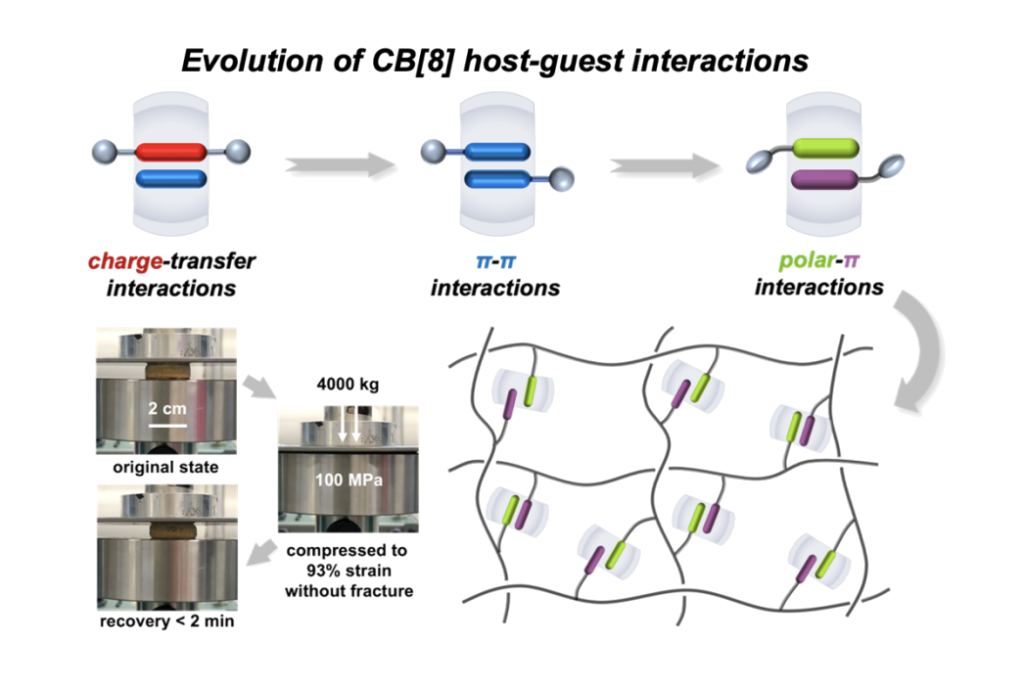
References:
[1] E. Appel, O. A. Scherman* et al. J. Am. Chem. Soc., 2010, 132, 14251.
[2] E. Appel, O. A. Scherman* et al. J. Am. Chem. Soc., 2012, 134, 11767.
[3] J. Liu, O. A. Scherman* et al. Adv. Mater., 2017, 29, 1605325.
[4] J. Liu, O. A. Scherman* et al. Adv. Mater., 2017, 29, 1604951.
[5] Z. Huang, O. A. Scherman* et al. J. Am. Chem. Soc., 2020, 142, 73, 7356.
[6] Z. Huang, O. A. Scherman* et al. Nat. Mater., 2022, 21, 103.
[7] S. J. K. O’Neill†
, Z. Huang†
, G. G. Malliaras, O. A. Scherman* et al. Adv. Mater., 2023, 35,
2207634.
Maria Hörnke
MLU Halle
“Biased membrane models: a lesson from antimicrobial peptides”
The interaction of antimicrobial peptides with lipid membranes can cause a variety of membrane perturbations. Systematic and mechanistic investigations are therefore crucial for the rational design of biomimetic compounds in the search for alternatives to classical antibiotics. Using various fluorescence methods and microcalorimetry, we thoroughly characterize membrane perturbations, most importantly membrane leakage induced by antimicrobial candidate molecules. With a focus on varying lipid compositions, we distinguish different leakage mechanisms and find that changes in leakage mechanisms in different membranes constitute an important contribution to selectivity for different microbial species or cells.
Most importantly, we establish membrane fusion in model vesicles to be a common leakage mechanism that is less relevant in microbes. Even worse, vesicles composed of phosphatidylglycerol and phosphatidylethanolamine commonly used to model bacterial membranes are biased for this leaky fusion, potentially leading to misinterpretation in widespread model studies. Various implications of leaky fusion and vesicle aggregation are discussed alongside strategies to prevent them. A positive aspect of our findings is that leaky fusion is probably useful for drug delivery applications.
Carla Schmidt
JGU Mainz
“A roadmap for SNARE complex assembly: Mass spectrometry uncovers intermediates and off-pathway complexes”
Proteins interact with other proteins and ligands to form catalytic centres fine-tuned for cellular actions. Accordingly, signal transmission between neurons relies on formation of the SNARE complex, which is responsible for fusion of synaptic vesicles with the presynaptic membrane. The SNARE complex assembles from vesicular Synaptobrevin-2 as well as SNAP25 and Syntaxin-1A, both anchored to the presynaptic membrane. During membrane fusion, the three SNARE proteins form a stable four-helix bundle, and the two membranes fuse. While many regulatory factors, including Complexin-1, have been identified, the underlying regulatory mechanisms are largely unknown. Importantly, neither the exact assembly sequence, nor the functional intermediates have been identified to-date.
Using native mass spectrometry and chemical cross-linking, we studied the assembly of the SNARE complex as well as interactions with Complexin-1 and provide a model of the SNARE complex in a regulatory resting state. Specifically, we explored multimerisation and complex formation of individual SNAREs, binary SNARE sub-complexes and intermediates as well as the fully assembled, ternary SNARE complex. We also investigated the role of Complexin-1 at all stages of SNARE complex assembly and provide insights into SNARE complex stabilisation and regulation. Following a combinatorial approach, we, therefore, uncovered preferred sub- complexes as well as off-pathway complexes and found that the stoichiometry of the fully assembled SNARE complex is preferred for all combinations. Importantly, Complexin-1 prevented self-association of the ternary SNARE complex. Our results provide mechanistic insights into formation of the SNARE complex helping us to establish fundamental rules for formation of the functionally active membrane fusion machinery.
Michael Vogel
TU Darmstadt
“Hydrogen-bonded liquids at biological and technological interfaces”
Hydrogen-bonded (HB) liquids show highly non-trivial molecular dynamics in their neat states and even more at interfaces in mixtures and confinements. Hence, suitable experimental and computational methods need to be combined to gain comprehensive understanding. Here, it is shown that applying various nuclear magnetic resonance (NMR) methods in combination with broadband dielectric spectroscopy (BDS) provides valuable insights into the rates and mechanisms for HB liquid dynamics in very broad time and temperature ranges. Moreover, it is exploited that molecular dynamics (MD) simulations yield microscopic details, e.g., about spatially heterogeneous dynamics near interfaces.
The possibilities of such combined experimental and computational approach are exploited to determine the effects of various types of biological and technological interfaces on the dynamical behaviors of neat and mixed HB liquids. A main focus will be water dynamics in mixtures and confinements at reduced temperatures, in particular their possible relation to water’s anomalies.
REFERENCES
(1) E. Steinrücken et al., J. Phys. Chem. Lett. 14, 4104 (2023)
(2) V. Schiller et al., J. Chem. Phys. 159, 034501 (2023)
(3) R. Horstmann et al., Langmuir 38, 6506-6522 (2022)
(4) M. Reuhl and M. Vogel, J. Chem. Phys. 157, 074705 (2022)
Annette Meister
MLU Halle
“The formation and electron microscopic characterization of artificial and native lipid-bilayer nanodiscs”
Certain amphiphilic copolymers form lipid-bilayer nanodiscs from artificial and natural membranes, thereby rendering incorporated membrane proteins optimal for structural analysis. Recent studies have shown that the amphiphilicity of a copolymer strongly determines its solubilization efficiency. This is especially true for highly negatively charged membranes, which experience pronounced Coulombic repulsion with polyanionic polymers. Here, we present a systematic study on the solubilization of artificial multicomponent lipid vesicles that mimic inner mitochondrial membranes, which harbor essential membrane- protein complexes. In particular, we compared the lipid-solubilization efficiencies of established anionic with less densely charged or zwitterionic and even cationic copolymers in low- and high-salt concentrations. The nanodiscs formed under these conditions were characterized by dynamic light scattering and negative-stain electron microscopy. Overall, our results show that some recent, zwitterionic copolymers are best suited to solubilize negatively charged membranes at high ionic strengths even at low polymer/lipid ratios [1].
As a proof of principle, we show an efficient recovery of protein-encapsulating nanodiscs from membranes of Chaetomium thermophilum, a thermophilic fungus. We identified ~1100 proteins by mass spectrometry and obtained two 3D reconstructions from cryo-EM for the nanodisc-containing cell extract. With this combined methodological approach, we provide a deeper understanding of eukaryotic membrane proteomes [2].
[1] Janson, K.; Zierath, J.; Kyrilis, F.L.; Semchonok, D.A.; Hamdi, F.; Skalidis, I.; Kopf, A.H.; Das, M.; Kolar, C.; Rasche, M.; Vargas, C.; Keller, S.; Kastritis, P.L.; Meister, A.; Biochim. et Biophys. Acta, Biomembr. 2021, 1863, 183725.
[2] Janson, K.; Kyrilis, F.L.; Tüting, C.; Alfes, M.; Das, M.; Träger, T.K.; Schmidt, C.; Hamdi, F.; Vargas, C.; Keller, S.; Meister, A.; Kastritis, P.L.; Biomacromolecules, 2022, 23, 5084-5094.
Eliane Roos
MLU Halle
“Unraveling the Interplay of Cellulose, DMSO and Four ILs: A Force Field Optimization”
Cellulose is one of the most important bio-polymers and has a broad range of applications. Because of its poor solubility in most solvents, only a small percentage of cellulose can be further processed. Ionic liquids such as 1-ethyl-3-methyl-1,2,3-triazolium acetate ([EMTr][OAc]) and DMSO as co-solvent can dissolve cellulose, but the reason for the solubility is still not fully understood. With the help of molecular dynamics (MD) simulations, it is possible to observe the solvation process on a molecular level. This can be realized by force field MD simulations instead of time-consuming ab initio MD simulations (AIMD). Therefore, we developed the novel force field BILFF(Bio-Polymers in Ionic Liquids Force Field) for four different ionic liquids, DMSO and cellulose [1-4] to reproduce radial (exemplarily shown in Fig. 1), spatial, and combined distribution functions, hydrogen bond lifetimes, diffusion coefficients, and several other quantities from reference AIMD simulations. The force field is validated by comparison to experimental data such as density, bulk modulus and thermal expansion coefficients at different temperatures. The development of BILFF enables further considerations of interactions, concentration-related effects and the behavior of the IL/H2O/DMSO/Cellulose system under external influences.
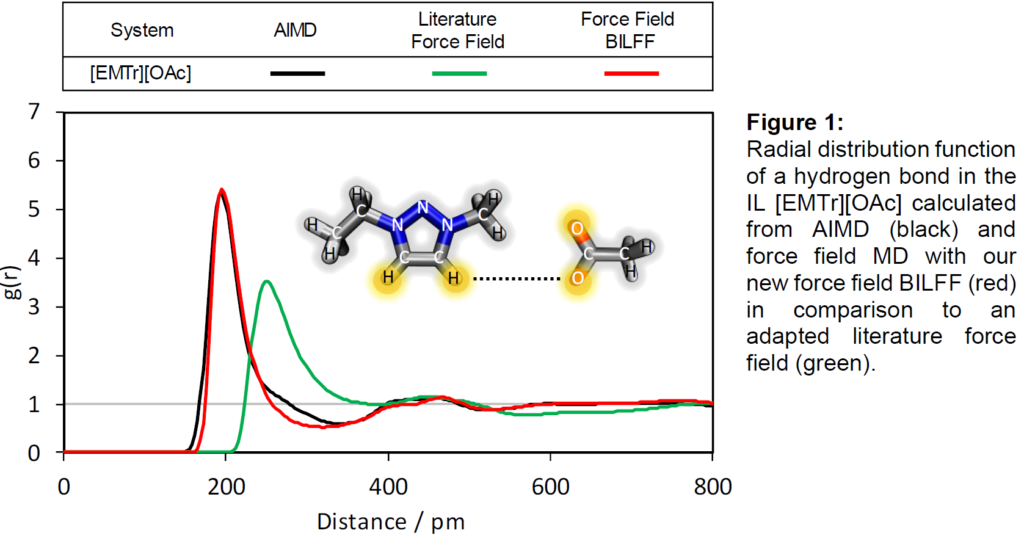
[1] E. Roos, M. Brehm, Phys. Chem. Chem. Phys. (2021), 23, 1242-1253.
[2] E. Roos, D. Sebastiani, M. Brehm, Phys. Chem. Chem. Phys. (2023), 25, 8755-8766.
[3] E. Roos, D. Sebastiani, M. Brehm, submitted.
[4] E. Roos, C. Gradaus, D. Sebastiani, M. Brehm, submitted.
Til Kundlacz
MLU Halle
“Deciphering protein-lipid interactions in solution and in the gas phase by native mass spectrometry”
Many biological processes depend on the interactions between membrane proteins and phospholipids. These interactions are diverse and include electrostatic interactions with lipid head groups as well as hydrophobic and van der Waals interactions with fatty acyl chains. Importantly, lipid membranes not only provide a stable environment for membrane proteins, they are also linked with their function and regulation. Accordingly, the analysis of protein-lipid complexes has become increasingly important. Native mass spectrometry is often used to identify and characterise specific protein-lipid interactions as it allows the study of intact complexes while preserving non-covalent interactions. However, it requires the transfer of the analytes into the gas-phase, where electrostatic interactions are enhanced and hydrophobic interactions do not exist. Accordingly, the question remains whether interactions that are observed in the gas-phase accurately reflect interactions that are formed in solution.
To address this question, we systematically explored non-covalent interactions between the antimicrobial peptide LL-37 and glycerophospholipids containing different head groups (PG, PC, PE, PA, PS lipids) or varying in fatty acyl chain length (ranging from 6:0/6:0 to 18:0/18:0). We observed differences in peak intensities for different protein-lipid complexes and dissociated these complexes by increasing the collisional energy to determine their relative binding strength in the gas-phase. Ion intensities and the relative binding strength correlate well for electrostatic interactions. Probing hydrophobic interactions by varying the length of fatty acyl chains, we observed differences in the ion intensities based on hydrophobic interactions in solution, while the relative binding strength showed only minor differences presumably originating from van der Waals interactions with the fatty acyl chains. In summary, our results demonstrate that electrostatic and hydrophobic interactions are reflected by ion intensities, while electrostatic interactions, including van der Waals interactions, determine the relative binding strength of complexes in the gas-phase.
Sandro Keller
Uni Graz
“New Native Nanodiscs for Membrane-Protein Biophysics”
Nanodiscs that harbour individual membrane proteins or membrane-protein complexes in a lipid-bilayer environment hold great promise for biophysical investigations under well-controlled yet native-like conditions. Our laboratory focusses on new methods for the direct, detergent-free extraction of proteins from cellular membranes into native nanodiscs, which preserve both the overall bilayer architecture and the local lipid composition of the original cellular membrane. Thus, these native nanodiscs render membrane proteins amenable to in vitro biophysical investigations without ever removing the proteins from a lipid-bilayer environment. Recently, we have developed and used novel amphiphilic polymers with improved properties for forming nanodiscs that are compatible with a broad range of ensemble and single-molecule biophysical techniques.[1–3] In this talk, I will present selected examples including antibody–receptor and peptide–lipid interactions studied by microfluidic diffusional sizing, membrane-protein complexes investigated by mass spectrometry, and cell-free translation of membrane proteins with cotranslational insertion into lipid-bilayer nanodiscs.

[1] D. Glück, A. Grethen, M. Das, O.P. Mmeka, E. Pérez Patallo, A. Meister, R. Rajender, S. Kins, M. Räschle, J. Victor, C. Chu, M. Etzkorn, Z. Köck, F. Bernhard, J.O. Babalola, C. Vargas, S. Keller. Electroneutral polymer nanodiscs enable interference-free probing of membrane proteins in a lipid-bilayer environment. Small 2022, 18, 2202492
[2] B. Danielczak, M. Rasche, J. Lenz, E. Pérez Patallo, S. Weyrauch, F. Mahler, M.T. Agbadaola, A. Meister, J.O. Babalola, C. Vargas, C. Kolar, S. Keller. A bioinspired glycopolymer for capturing membrane proteins in native-like lipid-bilayer nanodiscs. Nanoscale 2022, 5, 1855
[3] F. Mahler, A. Meister, C. Vargas, G. Durand, S. Keller. Self-assembly of protein-containing lipid-bilayer nanodiscs from small-molecule amphiphiles. Small 2021, 17, 2103603
Anna Luisa Upterworth
MLU Halle
“On the challenges of defining a quantitative and atomistic measure of philicity in liquid mixtures”
In chemistry and related fields, the concept of philicity is widely used and intuitively understood as the result of competing intermolecular forces. Two components, A and B, mix if the entropic advantage of a random spatial arrangement outweighs the enthalpic advantage of A-A and B-B interactions over A-B interactions. However, this understanding is only qualitative in nature. Aiming to provide a quantitative description of philicity, this work explores the relationship between the philicity of single atoms or functional groups and miscibility using force field molecular dynamic simulations.
Binary mixtures of n-alkanes with perfluoroalkanes are used as model systems as they are characterized by solely Van-der-Waals interactions and cover the entire range between phase separation and complete miscibility. Nevertheless, simulations with literature force field parameters come with some challenges, including difficulties in observing the phenomenon of phase separation and determining the boundary between mixed and separated phases.
After establishing a simulation setup and protocol, the impact of single force field parameters is studied through systematic variation. It is shown that increasing the strength of pairwise Van-der-Waals interactions enhances the phase separation of hexane and perfluorohexane. Overall, this work represents the first steps towards a more quantitative description of philicity in liquid mixtures.
